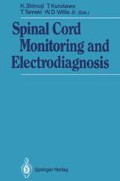Abstract
A monophasic positive potential is recorded when a nerve impulse approaches but never passes beyond the recording site. This type of potential has been termed the killed end potential (KP). Studies in experimental animals have repeatedly suggested a clinical value for the KP in localizing the level of spinal cord lesions [3, 4, 9]. The KP has been recorded intraoperatively in patients with spinal cord lesions [7, 10, 11]. We have also demonstrated that the KP of spinospinal responses can be readily recorded preoperatively in patients with eletrodes inserted percutaneously into the spinal epidural space and indeed has a value for localizing lesions [5].
Access this chapter
Tax calculation will be finalised at checkout
Purchases are for personal use only
Preview
Unable to display preview. Download preview PDF.
References
Borgens RB (1988) Voltage gradients and ionic currents in injured and regenerating axons. In: SG Waxman (ed) Advances in Neurology, vol 47: Functional Recovery in Neurological Disease, pp 51–66
Boyd S, Rothwell JC, Cowan JMA, Webb PJ, Morley T, Asselman P, Marsden CD (1986) A method of monitoring function in corticospinal pathways during scoliosis surgery with a note on motor conduction velocities. J Neurol Neurosurg Psychiatry 49: 251–257
Cracco RQ, Evans B (1978) Spinal evoked potential in the cat: effects of asphyxia, strychnine, cord section and compression. Electroencephalogr Clin Neurophysiol 44: 187–201
Deeke L, Tator CH (1973) Neurophysiological assessment of afferent and efferent conduction of the injured spinal cord of monkeys. J Neurosurg 39: 65–74
Katayama Y, Tsubokawa T, Yamamoto T, Hirayama T, Maejima S (1988) Preoperative determination of the level of spinal cord lesions from the killed end potential. Surg Neurol 29: 91–94
Katayama Y, Tsubokawa T, Maejima S, Hirayama T, Yamamoto T (1988) Corticospinal direct response in humans: identification of the motor cortex during intracranial surgery under general anesthesia. J Neurol Neurosurg Psychiatry 51: 50–59
Kurokawa T (1978) Electrospinogram. Brain and Nerve 30: 467–484 (in Japanese)
Levy WJ, York DH, McCaffrey M, Tanzer F (1984) Motor evoked potentials from transcranial stimulation of the motor cortex in humans. Neurosurgery 15: 287–302
Schramm J, Krause R, Shigeno T, Brock M (1983) Experimental investigation on the spinal cord evoked injury potential. J Neurosurg 59: 485–492
Tamaki T, Yamane T (1975) Clinical utilization of the evoked spinal cord action potential in spine and spinal cord surgery. Electroencephalogr Clin Neurophysiol 39: 539 (abstract)
Tsubokawa T, Katayama Y, Maejima S, Hirayama T, Yamamoto, T (1987) Assessment of spinal cord injury. Neuro–orthopedics 3–82–89
Author information
Authors and Affiliations
Editor information
Editors and Affiliations
Rights and permissions
Copyright information
© 1991 Springer-Verlag Berlin Heidelberg
About this paper
Cite this paper
Katayama, Y., Tsubokawa, T., Maejima, S., Hirayama, T., Yamamoto, T. (1991). Killed-End Corticospinal Motor Evoked Potential (MEP) in Patients with Spinal Cord Injury. In: Shimoji, K., Kurokawa, T., Tamaki, T., Willis, W.D. (eds) Spinal Cord Monitoring and Electrodiagnosis. Springer, Berlin, Heidelberg. https://doi.org/10.1007/978-3-642-75744-0_62
Download citation
DOI: https://doi.org/10.1007/978-3-642-75744-0_62
Publisher Name: Springer, Berlin, Heidelberg
Print ISBN: 978-3-642-75746-4
Online ISBN: 978-3-642-75744-0
eBook Packages: Springer Book Archive

